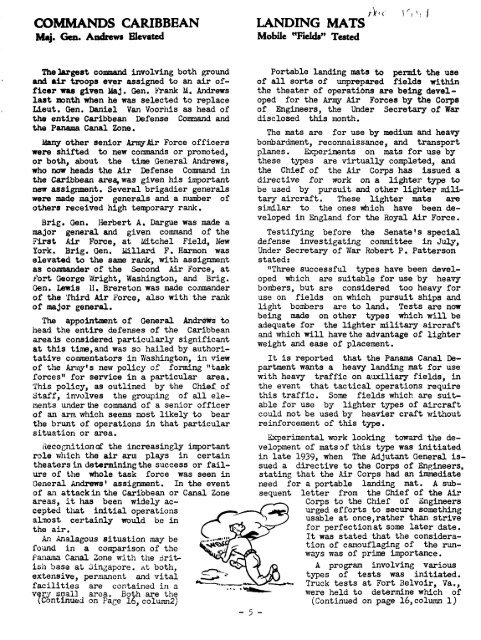News Letter 1941 Jul-Dec - Air Force Historical Studies Office
News Letter 1941 Jul-Dec - Air Force Historical Studies Office
News Letter 1941 Jul-Dec - Air Force Historical Studies Office
Create successful ePaper yourself
Turn your PDF publications into a flip-book with our unique Google optimized e-Paper software.
COMMANDS<br />
CARIBBEAN<br />
Maj. Gen. ADCIrews Blevated<br />
LANDING<br />
MATS<br />
Mobile "Fields" Tested<br />
t~!(<br />
\ r'! l: I<br />
The Jargest command involving both ground<br />
and air troops ev~r assigned to an air ofricer<br />
was given Maj. Gen. Frank M. Andrews<br />
last month when he was selected to replace<br />
Lieut. Gen. Daniel Van Voorhis as head of<br />
the entire Caribbean Defense Command and<br />
the Panama Canal Zone.<br />
Many other senior Army<strong>Air</strong> <strong>Force</strong> officers<br />
were shifted to new commands or promoted,<br />
or both, about the time General Andrews,<br />
who now heads the <strong>Air</strong> Defense Command in<br />
the Caribbean area, was given his important<br />
new assignment. Several brigadier generals<br />
were made major generals and a number of<br />
others received high temporary rank.<br />
Brig. Gen. Herbert A. Dargue was made a<br />
major general and given command of the<br />
First <strong>Air</strong> Foree, at Mitchel Field, New<br />
York. Brig. Gen. LAillard F. Harmon was<br />
elevated to the same rank, with assignment<br />
as commander of the Second <strong>Air</strong> <strong>Force</strong>, at<br />
.fort George Wright, Washington, and Brig.<br />
Gen. Imris 11. Brereton was made commander<br />
of the Third <strong>Air</strong> <strong>Force</strong>, also with the rank<br />
of major general.<br />
The appointment of General Andrews to<br />
head the entire defenses of the Caribbean<br />
areais considered particularly significant<br />
at this time, and was so hailed by authoritative<br />
commentators in Washington, in view<br />
of the Array's new policy of forming "task<br />
forces" for service in a particular area.<br />
This policy, as outlined by the Chie! of<br />
Staff, in'lolves the grouping of all elements<br />
under the command of a senior officer<br />
of an arm which seems most likely to bear<br />
the brunt of operations in that particular<br />
situation or area.<br />
iiecoGnitionaf the increasingly important<br />
role which the air arm plays in certain<br />
theaters in determining the success or failure<br />
of the whole task force was seen in<br />
General Andrews' assignment. In the event<br />
of an attack in the Caribbean<br />
areas, it has been widely<br />
or<br />
accepted<br />
Canal Zone<br />
tl>at initial operations<br />
aL~ost certainly would be in<br />
the air.<br />
An Analagous situation may be<br />
found in a comparison of the<br />
Panama Canal Zone with the British<br />
base at Singapore. At both,<br />
extensive, permanent and vital<br />
facilities are contained in a<br />
v~ry small aroa , Both are the<br />
lContinued on Pace 16, column2)<br />
Portable landing mats to permit the use<br />
of all sorts of unprepared fields within<br />
the theater of operations are being developed<br />
for the Army <strong>Air</strong> <strong>Force</strong>s by the Corps<br />
of Engineers, the Under Secretary of War<br />
disclosed this month.<br />
The mats are for use by medium and heavy<br />
bombardment, reconnaissance, and transport<br />
planes. Experiments on mats for use by<br />
these types are virtually completed, and<br />
the Chief of the <strong>Air</strong> Corps has issued a<br />
directive for work on a lighter type to<br />
be used by pur sui t and other lighter military<br />
aircraft. These lighter mats are<br />
similar to the ones which have been developed<br />
in England for the Royal <strong>Air</strong> <strong>Force</strong>.<br />
Testifying before the Senate's special<br />
defense investigating committee in <strong>Jul</strong>y,<br />
Under Secretary of War Robert P. Patterson<br />
stated:<br />
"Three successful types have been developed<br />
which are suitable for use by heavy<br />
bombers, but are considered too heavy for<br />
use on fields on which pursuit ships and<br />
light bombers are to land. Tests are now<br />
being made on other types which will be<br />
adequate for the lighter military aircraft<br />
and which will have the advantage of lighter<br />
weight and ease of placement.<br />
It is reported that the Panama Canal Department<br />
wants a heavy landing mat for use<br />
with heavy traffic on auxiliary fields, in<br />
the event that tactical operations require<br />
this traffic. Some fields which are suitable<br />
for use by lighter types of aircraft<br />
could not be used by heavier craft without<br />
reinforcement of this type.<br />
Experimental work looking toward the development<br />
of mats of this type was initiated<br />
in late 1939, when The Adjutant General issued<br />
a directive to the Corps of Eneineers,<br />
stating that the <strong>Air</strong> Corps had an immediate<br />
need for a portable landing mat. A subsequent<br />
letter from the Chief of the <strong>Air</strong><br />
Corps to the Chief of Engineers<br />
urged efforts to secure something<br />
usable at once, rather than strive<br />
for perfection at some later date.<br />
It was stated that the consideration<br />
of camouflaging of the runways<br />
was of prime importance.<br />
A program involving various<br />
types of tests was initiated.<br />
Truck tests at Fort Belvoir, Va.,<br />
were held to determine which of<br />
(Continued on page l6,column 1)<br />
- 5 -
















